Mapping the Workforce of Tomorrow
Workforce of Tomorrow
Mapping the Workforce of Tomorrow
Automations Impact
The future of work is progressing like a shot from a high caliber rifle, driven by the rise of artificial intelligence (AI) and automation. The promise of automation is that it will wildly enhance productivity and dramatically streamline operations, it will absolutely transform the workforce in profound ways. As machines take over more routine tasks, some sectors will flourish while others will perish. Understanding which industries are most vulnerable to automation and how specific occupations will evolve is vital for both businesses and individuals navigating this seismic shift.
In this blog, we’ll map out the workforce of tomorrow. We will inspect the sectors most affected by automation, identify high-risk occupations, and explore case studies that highlight the rapid changes brought on by AI.
Workforce Segmentation: Vulnerability to Automation
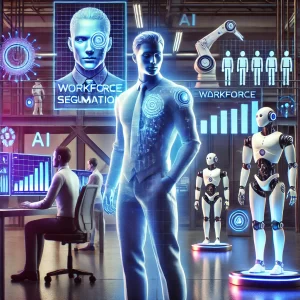 Automation’s impact will not be felt equally across all industries. According to McKinsey Global Institute’s extensive research, the level of risk posed by automation varies greatly depending on the nature of the work, the industry’s reliance on routine tasks, and the potential for AI to enhance or replace human labor. Below, we segment the workforce into categories of vulnerability:
Automation’s impact will not be felt equally across all industries. According to McKinsey Global Institute’s extensive research, the level of risk posed by automation varies greatly depending on the nature of the work, the industry’s reliance on routine tasks, and the potential for AI to enhance or replace human labor. Below, we segment the workforce into categories of vulnerability:
•Routine Manual Labor: Industries that rely heavily on repetitive physical tasks are among the most vulnerable to automation. Sectors like manufacturing, agriculture, and warehousing have already seen massive disruption caused by robotics. Machines are increasingly taking over repetitive tasks like assembly, packaging, and harvesting. According to McKinsey, automation could displace up to 15-25% of jobs in these industries by 2030, particularly affecting roles like machine operators and laborers. The machines aren’t coming, they’re already here! Virtually no industry will remain untouched.
•Service and Retail: Service sectors that rely on human interactions and routine processes—including retail, hospitality, and food services—are at risk, particularly in entry-level positions. Self-checkout machines, robotic cooks, and AI-driven customer service bots are just a few examples of how automation is penetrating these industries. McKinsey estimates that 20-30% of jobs in retail could be automated in the coming decade.
•Transportation and Logistics: With the rise of autonomous vehicles, the Tesla RoboTaxi, and drones, the transportation and logistics sector is primed for significant disruption. Long-haul trucking, delivery services, and warehousing are particularly vulnerable as autonomous trucks and drone deliveries become more viable. McKinsey’s research suggests that 40-50% of transportation jobs could be displaced by 2035 as automation and AI technology mature.
•Healthcare and Education: While healthcare and education are less vulnerable to full automation due to the complexity of human interaction and emotional intelligence required, certain routine tasks—such as diagnostics in radiology and administrative tasks in healthcare—are at risk. AI-powered tools are already assisting in diagnoses and personalized learning. However, McKinsey forecasts that less than 10% of jobs in healthcare and education are likely to be automated by 2030, with the greatest impact being felt in administrative and routine operational roles.
•Knowledge Work: White-collar jobs involving cognitive work, such as finance, legal services, and marketing, are also subject to automation, though in different ways. AI is revolutionizing tasks like data analysis, legal research, and financial trading. While these industries won’t see the widespread displacement of jobs, McKinsey estimates that up to 35% of work in these sectors could be automated, especially repetitive tasks like contract review or bookkeeping.
As you can tell, some sectors are more at risk than others, the future of work will be defined by how well industries can adapt to these changes and how individuals upskill to remain competitive.
High-Risk Occupations: Jobs Likely to Be Displaced and Evolved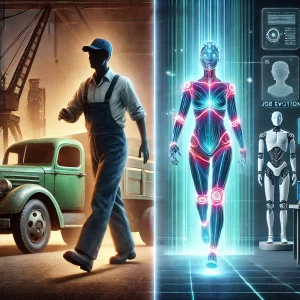
As automation progresses, certain jobs will be more vulnerable than others. McKinsey’s research has identified several occupations that are likely to see significant displacement:
•Manual and Low-Skilled Labor: Jobs in manufacturing, warehousing, and agriculture that require repetitive manual tasks are at the highest risk of displacement. For example, positions like assembly line workers, material handlers, and agricultural laborers are already being replaced by robots and AI systems. Machines can perform these tasks faster, more accurately, and without the limitations of human fatigue.
•Data-Intensive Roles: Occupations that rely on the processing and analysis of large data sets, such as financial analysts, bookkeepers, and administrative assistants, are increasingly being supplemented or replaced by AI systems. AI-powered algorithms can perform data entry, manage accounts, and forecast financial trends more efficiently than humans. As a result, jobs in this field are expected to shrink by 15-20% by 2030.
•Transportation Jobs: As autonomous vehicles become more sophisticated, jobs such as truck drivers, delivery personnel, and taxi drivers are at risk. Long-haul trucking in particular is poised for disruption, with autonomous trucking technology set to replace up to 50% of human drivers by 2035. While there will still be a need for human oversight, the number of driving jobs is likely to shrink significantly.
However, while many jobs are at risk of being displaced, others will evolve:
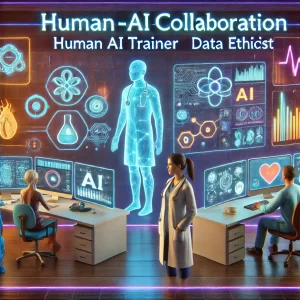 •Human-AI Collaboration: As machines take over repetitive tasks, new roles will emerge that involve collaborating with AI systems. For instance, jobs like AI trainers, data ethicists, and robotics engineers will see growth. These roles require human oversight to guide, improve, and ensure ethical AI operations.
•Human-AI Collaboration: As machines take over repetitive tasks, new roles will emerge that involve collaborating with AI systems. For instance, jobs like AI trainers, data ethicists, and robotics engineers will see growth. These roles require human oversight to guide, improve, and ensure ethical AI operations.
•Healthcare and Social Work: While some administrative tasks in healthcare may be automated, roles that require empathy, human interaction, and complex decision-making—such as nurses, doctors, social workers, and therapists—will evolve. These professions will increasingly leverage AI tools to enhance decision-making while still relying on human judgment and emotional intelligence.
•Creative and Strategic Roles: Jobs that require creativity, critical thinking, and innovation will see growth. Fields like marketing, product design, content creation, and entrepreneurship will thrive, as these roles are less susceptible to automation. The ability to connect with consumers on a human level will remain crucial, especially in fields like network marketing and digital marketing.
Case Studies: Industries Undergoing Rapid Change
Several industries are already experiencing rapid shifts due to AI and automation. Below are case studies that illustrate the evolving landscape:
•Manufacturing and Robotics: One of the first industries to undergo significant automation, manufacturing continues to evolve with the integration of AI-driven robots. For example, Tesla’s Gigafactory has implemented automated production lines with minimal human oversight, producing electric cars more efficiently than ever. While robots have displaced many assembly line workers, the demand for highly skilled technicians to maintain and program these robots has increased.
•Finance and AI-Powered Trading: The financial services industry has been quick to adopt AI-driven tools for stock trading, data analysis, and risk management. Goldman Sachs reduced its trading desk staff from 600 traders to 2 after implementing AI-powered trading algorithms. While this has displaced many traditional traders, new roles in algorithm management and AI system oversight have emerged.
•Retail and E-Commerce: The retail industry is seeing a massive transformation with the rise of e-commerce platforms and automation in distribution centers. Amazon is at the forefront of this shift, using robots to fulfill orders in its warehouses and AI-driven customer service tools to handle inquiries. While these changes have reduced the need for warehouse and customer service staff, they have also created new jobs in logistics management and e-commerce strategy.
These case studies demonstrate that while certain jobs may be eliminated, others are being created or transformed, offering opportunities for those who are willing to adapt.
Digital Marketing in the Age of Disruption: Thriving in the New Economy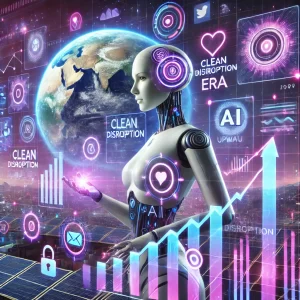
While many jobs face the risk of displacement, there’s a growing opportunity for individuals to create their own path to financial independence by embracing digital marketing. As we’ve discussed in our previous blog series on “Digital Marketing in the Age of Clean Disruption,” based on the groundbreaking research of Tony Seba and his team at RethinkX, the world is undergoing a fundamental transformation in how we produce, consume, and engage with technology. This disruption is not just limited to energy and transportation—it’s affecting every industry, creating new avenues for entrepreneurial success.
In our blog “Why Personal Digital Marketing Businesses Are the Future”, we explored how building your own digital marketing business can provide security and financial freedom in this age of rapid technological change. As AI and automation reshape traditional industries, there is still immense demand for personal, human-centric marketing efforts. Network marketing, affiliate marketing, and digital coaching businesses are thriving in a world where automation cannot replicate the nuance of human relationships, creativity, and emotional intelligence.
The Power of Personal Branding and Human-Centric Marketing
Moreover, in “Embracing Digital Marketing to Stay Ahead of the Disruption”, we discussed how this clean disruption creates an urgent need for people to rethink how they engage with their own careers. The shift toward renewable energy and automation offers new digital avenues to reach a global audience. Digital marketing allows you to build a business with minimal overhead, low barriers to entry, and the freedom to create content that resonates with consumers in ways that machines cannot replicate.
Furthermore, if you’re wondering where to begin, the key is to harness the power of personal branding, content creation, and human connection. As highlighted in “How Digital Marketing Empowers Entrepreneurs in the Age of Automation”, individuals who are willing to leverage technology while focusing on personal engagement and creativity can build thriving businesses. Through digital platforms, you can reach your ideal audience, connect with like-minded individuals, and grow a personal brand that stands resilient in the face of automation.
The rise of automation doesn’t mean the end of opportunity—it simply signals a shift toward personal ownership of your career and future. By tapping into the power of digital marketing, you can not only survive but thrive in this new economy. The future is in your hands, and now is the perfect time to embrace the entrepreneurial opportunities that digital marketing provides.
The Road Ahead
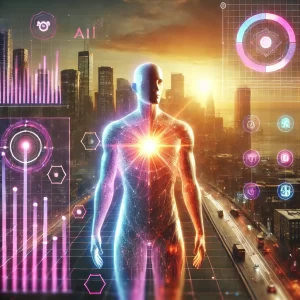 As we map out the workforce of tomorrow, one thing is clear: the future will be shaped by how well individuals and industries adapt to the rise of automation. While some jobs will be displaced, others will evolve and new opportunities will emerge. The key to thriving in this new era lies in embracing change, upskilling, and finding ways to collaborate with AI and automation systems.
As we map out the workforce of tomorrow, one thing is clear: the future will be shaped by how well individuals and industries adapt to the rise of automation. While some jobs will be displaced, others will evolve and new opportunities will emerge. The key to thriving in this new era lies in embracing change, upskilling, and finding ways to collaborate with AI and automation systems.
For those who are prepared, the future offers a wealth of opportunities. Whether through embracing human-centric fields like healthcare and creative industries, or leveraging network marketing and digital marketing strategies, the workforce of tomorrow is brimming with potential. Now is the time to prepare, adapt, and thrive in the age of AI and automation.
To ensure you’re ready for the future, we invite you to explore our online course, Mastering the Art of Wealth Creation: A Journey Through Mind Power and Marketing. This course is designed to equip you with the tools, strategies, and mindset needed to build a thriving personal business in the digital age. Learn how to harness the power of digital marketing and network marketing, and position yourself for long-term success in this rapidly changing world.
Start preparing for your future today—enroll in our course and take control of your career in the age of AI and automation.
#FutureOfWork, #AutomationImpact, #AIDrivenWorkforce, #DigitalMarketing, #WorkforceSegmentation, #JobEvolution, #McKinseyResearch

John Rogers is a former Wall Street portfolio manager and served as CEO of Premium Enterprises and President of The Colorado Tire Recycling Center. He transitioned to digital marketing, founding WealthCreationMastermind.com to empower home-based entrepreneurs with cutting-edge strategies. Creator of the “Mastering the Art of Wealth Creation” online course, John has driven significant growth in network marketing, achieving the Blue Diamond rank and earning the title of Univera Associate of the Year in 2015. His expertise in leveraging technology for financial success transforms how entrepreneurs achieve their business goals.